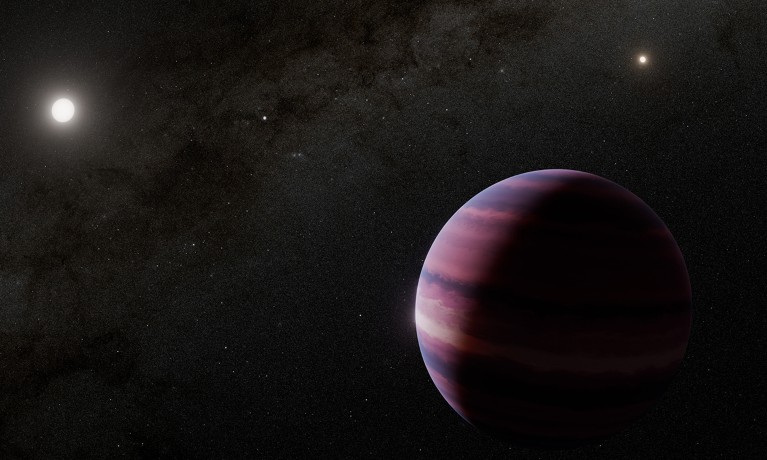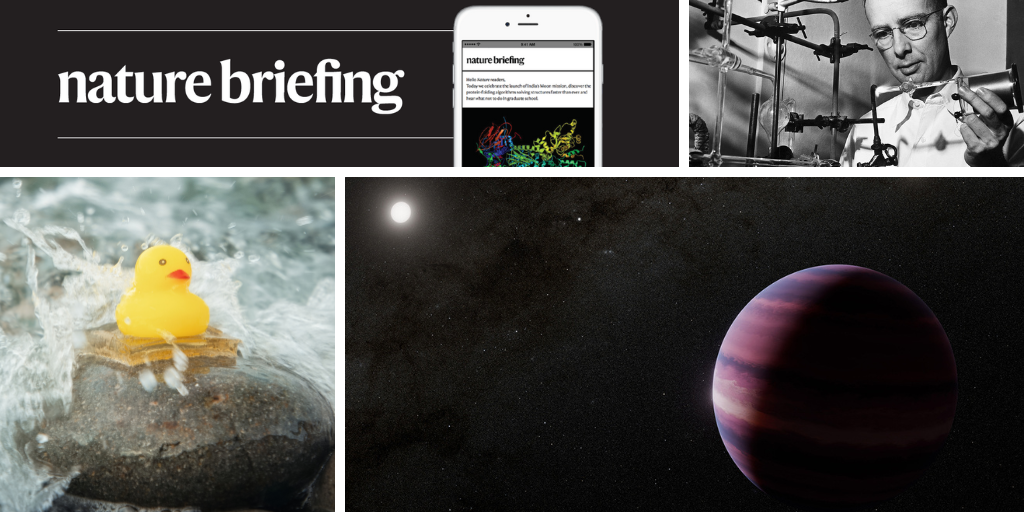You have full access to this article via your institution.
Hello Nature readers, would you like to get this Briefing in your inbox free every day? Sign up here.

An artist’s concept of a possible gas-giant planet with the two stars Alpha Centauri A and B. Credit: NASA, ESA, CSA, STScI, R. Hurt (Caltech/IPAC)
Astronomers have caught a glimpse of what could be a nearby planet in its star’s habitable zone — the ‘just right’ region where life could flourish. The planet, which appears as no more than a bright smudge on images taken by the James Webb Space Telescope, is circling Alpha Centauri A, just 4 light years from Earth. Because it’s a gas giant, researchers aren’t holding their breath for life on this planet, but its moons could be habitable, they say.
Reference: arXiv preprint 1 & preprint 2 (not peer reviewed)
A report released last week by the US Department of Energy that concluded that global warming is “less damaging economically than commonly believed” has spurred climate scientists into action. A group of researchers are now trying to coordinate a unified response, knowing that their arguments could influence a legal battle that is likely to go to the US Supreme Court. The report is “a revision of science and a revision of history. We have to respond”, says climate scientist Benjamin Santer. “The alternative is to do nothing,” says atmospheric scientist Andrew Dessler. “I just don’t think I can do that.”
Stone tools found on Sulawesi in Indonesia suggest that ancient humans called hominins occupied the island around 1 million years ago — much earlier than we thought. The small tools were probably created using a percussion-flaking technique, in which a rock is struck with another stone to create sharp edges. Without fossils, researchers can’t tell exactly which early human species made them, but Homo erectus is a potential candidate, says archaeologist and study co-author Adam Brumm.
Features & opinion
From flying on the plane that dropped an atomic bomb to publicly weighing in on whether UFOs existed, physicist Luis Alvarez is “a biographer’s dream”, writes philosopher Robert Crease in his review of Alec Nevala-Lee’s new book Collisions. The challenge, Crease says, is describing the varied science that drove Alvarez. But Nevala-Lee, an experienced biographer and novelist, is up to the task. The book sidelines some dimensions of Alvarez’s life, such as his right-wing politics, but ultimately “shows the passionate intensity of someone whose pursuit of physics sprang directly from the desire to understand and navigate the world,” Crease writes.
Artificial intelligence heals an abandoned Earth in After you left and the conditions on a new planet warrant a little bodily modification in A rude awakening.
Nature | 5 min read & Nature | 6 min read
Andrew Robinson’s pick of the top five science books to read this week includes the history of tattooing and an illustrated list of 50 plants that have saved the world.
With the help of artificial intelligence, researchers have developed a new type of adhesive that can be used underwater. Inspired by the grip of creatures such as barnacles, the material is capable of securely fastening objects together even when immersed in salty water. To test their adhesive, the team used it to glue a rubber duck to a rock on the beach, where it stayed stuck firmly, despite being battered by waves, until they chose to remove it.
Nature Podcast | 28 min listen
Or, to see the hydrogel in action, watch Nature’s 2 min videoSubscribe to the Nature Podcast on Apple Podcasts, Spotify or YouTube Music, or use the RSS feed.
Today, Leif Penguinson is getting lost in Gwaii Haanas, a conservation area and heritage site in British Columbia, Canada. Can you find the penguin?
The answer will be in Monday’s e-mail, all thanks to Briefing photo editor and penguin wrangler Tom Houghton.
This newsletter is always evolving — tell us what you think! Please send your feedback to [email protected].
Thanks for reading,
Jacob Smith, associate editor, Nature Briefing
• Nature Briefing: Careers — insights, advice and award-winning journalism to help you optimize your working life
• Nature Briefing: Microbiology — the most abundant living entities on our planet — microorganisms — and the role they play in health, the environment and food systems
• Nature Briefing: Anthropocene — climate change, biodiversity, sustainability and geoengineering
• Nature Briefing: AI & Robotics — 100% written by humans, of course
• Nature Briefing: Cancer — a weekly newsletter written with cancer researchers in mind
• Nature Briefing: Translational Research — covers biotechnology, drug discovery and pharma


